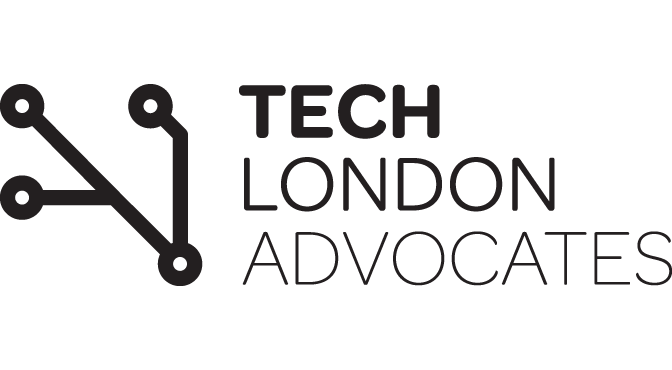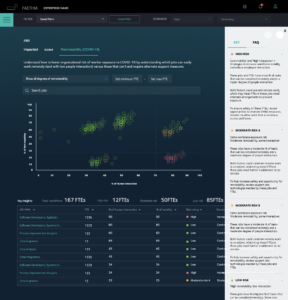MICHAEL PRIDDIS
FAETHM AI


New Data Science in support of Covid-19 Business Resilience from Faethm AI
WEDNESDAY 08 APRIL
Three weeks ago, when the US reported their second COVID-19 case and people were still walking to the shops in Italy, Faethm saw the risk of workplace exposure.
We saw the difficulties ahead as we all work to identify how to keep our teams safe while maintaining productivity. We started to build the Business Resilience module.
First we modelled scenarios of pandemic and epidemics to understand potential COVID-19 transmission in each country.
We then built a new neural network and applied this to our Occupation Ontology (and tasks in every job) across any organisation to create our first Resilience features showing:
- Which jobs in a specific workforce are most at risk based on the degree of interactivity with others
- Which jobs have tasks that can be completed remotely to enable remote work or job transitions
We will continue to add new analytics and features to the Business Resilience module in the weeks ahead. Read on to see examples of these upcoming priority features.
Testing with clients and partners began last week. We are now contributing to workforce and policy planning with government and healthcare clients in Australia.
We are also applying this to census datasets to support Government policy and corporate strategy with clients globally.
This module will help to ‘flatten the curve’ of COVID-19 transmission, keeping workforces safer and lowering demand for ICU and healthcare.
I and the whole Faethm team wish you, your team and families our very best now and through the months ahead.
– Mike
//
Faethm AI is a fast-growth and globally unique SaaS platform – the world’s data source for the Fourth Industrial Revolution. Faethm blends proprietary analytics with client data to predict the impact of emerging technologies on any job, workforce, company, industry, location or economy.
Launched in late 2017, Faethm is already used by over 75 leading companies and governments spanning 20 industries & 24 countries. Users include: MasterCard, Zurich Insurance, KPMG, PwC, the UK Government, Australian, Canadian and Luxembourg governments, Capgemini, Rio Tinto and Singtel.
Faethm is also the only company focused on Future or Work issues to be invited by the World Economic Forum (WEF) to join their Centre for the 4th Industrial Revolution in San Francisco, and Faethm sits on the WEF’s Global AI Council.
Major consulting and technology firms have also signed global, regional and national partnership agreements to distribute Faethm to their clients, including Aon Hewitt, Capgemini, DXC Technology, EY, KPMG, Mars Discovery District, Mercer, PwC, Randstad, The Boston Consulting Group (BCG) and Willis Towers Watson.
Faethm has built a new neural network to help you navigate COVID-19 workforce risk, impact and productivity.
The new neural network is now live on the Faethm platform and delivering Job Remoteability and COVID-19 Workforce Risk insights to clients. More Resilience Module features are coming in April to support you through and beyond the pandemic.
Most organisations have now sent staff home. Very few are working remotely effectively. Faethm features available now and in development will help you to lift productivity immediately.
There is an immediate need to ensure your workforce is resilient and working remotely in the right jobs, on the right tasks with the right technologies.
Over the previous weeks, we’ve spoken to customers and partners globally to learn what our clients need. We’ve already released new analytics and features allowing you to plan ahead and see how Faethm will help you to keep your organisation working and safe during the pandemic.
Phase 1: Job Remoteability and COVID-19 Risk – now live (see below)
Phase 2: New filters to support continuity planning (early April)
- Pandemic essential jobs showing jobs that are required to maintain essential services and ensure continuity of society during a pandemic
- Recession resilient jobs showing a categorisation of jobs as high, medium and low risk of redundancy based on past recession data
- Job categories filtering 24 major profession groupings like Technology, Medical, Production for all jobs in Faethm to enable higher-level reporting
- Continuity critical jobs showing the jobs central to core enterprise and public sector continuity in the face of continuity disruptions. *In feasibility assessment
Users will be able to leverage new filters with existing filters like age and locations to understand possible impact scenarios associated with demographic insights.
There is also the opportunity to maximise custom filters and provide other HCM system fields such as internal classification of critical jobs, leave status and more.
Job Remotability is now live. See features below:
Leverage Job Remoteability insights in Faethm to:
- Identify which jobs are exposed to productivity disruption those can sustain operating remotely based on their remoteability score
- Explore the degree of remoteabilityand people interaction in all jobs within your workforce dataset to anticipate workplace exposure risk
- Understand the four categories of workplace exposure risk that jobs fall into and associated actions to support jobs and workers
- Apply location,age, and other filters to hone in on different parts of your workforce to tailor job and worker support accordingly
- Align continuity action planning through sharing exports and expanding your user base to include your organisation’s COVID-19 task force
- Leverage the custom filters to classify business-critical work and transition at-risk workers to secure and high need jobs
This circumstance provides an opportunity to pause and re-evaluate business operations and make strategic decisions as to how the enterprise wants to rebuild its people and structures for the future, fueled by Faethm’s data. For example, across People, Technology and Strategy lenses:
- Consider which employees might remain fully remote in the future. How might you guide and maintain a positive culture, and equip its leaders, within dispersed team environments?
- How might post-COVID remoteability commitments position your organization as having a strong, digitally enabled employee value proposition (EVP)?
- How can more of the workforce be upskilled towards business critical and ‘future proof’ skills to support their relevance and longevity in the organization?
- Can this broaden geographic talent pools and expand your hiring potential?
- How might technology investments be reprioritized to better enable remoteable staff, or mitigate against future shock?
- Which AI & Robotic technologies can support business critical tasks in the future, and reduce the risk of external shocks?
- Which technologies are available to immediately replace on-site tasks? How do you re-prioritise your automation investment roadmap?
- What non-business critical roles might be divested of as we return from this crisis? Can there be strategic decisions made about core vs. non-essential offerings?
- Explore the impact of a more remote workforce on physical offices. Are there potential cost savings around real-estate investments?
- How can the organizational structure evolve to accommodate the more distributed workforce?
- When reviewing long-term automation rates of employees, can the workforce needs be re-evaluated? Can short-term or contract resources be hired in the interim while technologies are being fully implemented?
- Review and adjust long term real-estate and properties/facilities strategy to understand cost saving potentials for future workforce location and composition.
Please contact [email protected] to understand more and receive a live demo of the Faethm platform and the new Business Resilience Module.
If you would like to share an article or any advice to be included, please send it to [email protected]



